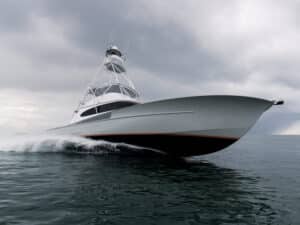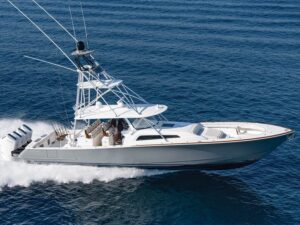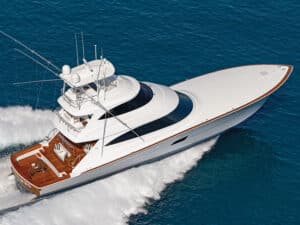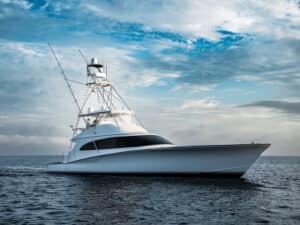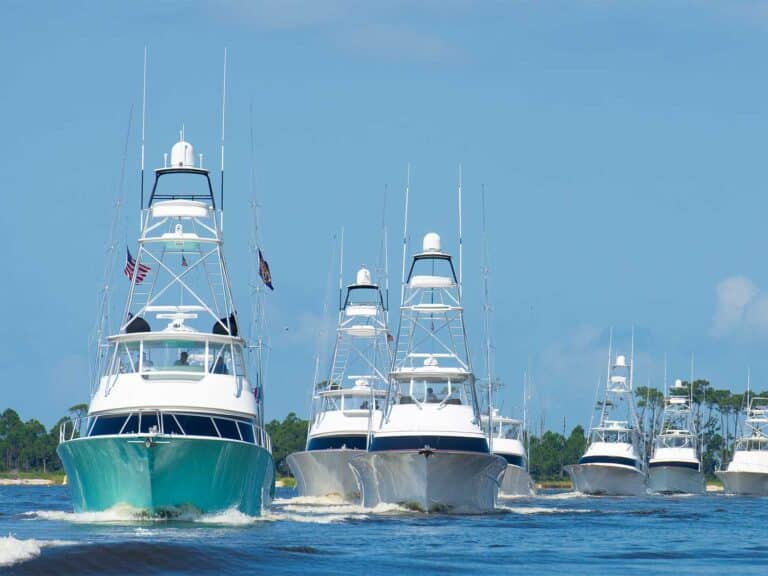This year, Egg Harbor celebrates its 50th anniversary by introducing a timeless design from Dave Martin that not only reflects the company’s long history in the sport-fish business, but also points to future boatbuilding innovations as well.
Whether intentionally or by accident, Martin’s design for the company’s new 52 Golden Egg represents somewhat of a hybrid of several types of hulls. A very sharp entry and generous flare reminds you of a Carolina hull, but the bottom flattens out immediately at the point of entry, much like many of Martin’s typical Jersey designs. And the extremely flat aft reminds you of the Florida go-fast boats.
The result is an interesting combination of head-sea ability, a bone-dry ride, good stability in a beam sea, and a hull that wants to get out and on top of the water quickly upon acceleration. In 2- to 3-foot seas, the 52 proved a good ride, whether trolling, drifting or running full bore. At full speed, she lifts out of the water and rides the surface well, without any noticeable pounding in the admittedly small swells we encountered on our test day.
This top-of-the-water attitude makes the 52 not only fast, but economical as well. Fishing hull No. 2 off Stuart, Florida, we pushed her 8V MTUs to their top end of 2,450 rpm and hit a respectable 34 knots. At that speed, she consumed a reasonable 80 gallons per hour. At a fast cruise speed of 31 knots at 2,200, she drinks 70 gph for an approximate range of 360 nautical miles. Of course, a more conservative cruise would yield a better range.
Bridge
Without a doubt, this 52’s most prominent feature is her flybridge, which is absolutely huge. In fact, it’s the same bridge sole Egg Harbor will use on its 58-footer, and even on that boat it’s plenty big. Up in front of the helm, a U-shaped settee (with rod storage underneath) will seat a half-dozen passengers, though a few of them may not enjoy having their back to the bow when under way. More realistically, the settee offers a comfortable napping area for two or three.
On the starboard side, Egg Harbor has replaced the side bench seat, which to me is the most uncomfortable spot on the boat when under way anyway, with a cabinet which houses storage and a wet bar. The helm itself is of a good size, and overhead boxes assure plenty of room for electronics. An entry port to the helm offers easy access to all wiring and flush-mounted electronics.
Behind the two helm seats, this bridge’s vast size is most readily apparent. While on some boats you have to hold your breath and squeeze behind the captain’s seat to get to the passenger’s helm chair, you and a partner could waltz your way there on the Egg Harbor, thanks to an extended cockpit overhang that provides a full 4 feet of clearance between the chair and the rocket launcher.
Cockpit
While the 52’s cockpit is a touch smaller than that of some other boats in this size range, this 89-square-foot fishing platform offers more than adequate space for a full crew and fighting chair. Diamond nonskid assures traction, though some type of toe rail would be nice for leaning out over the gunwales since you can’t effectively tuck your knees under them, thanks to the flush storage compartments on each side. These compartments, though nice for stowing mops, gaffs and the like, also rob the boat of any under-gunwale rod storage. And with the bridge rod holders out of reach of even a 6-footer, you’ll definitely want to opt for either a chair or cockpit rocket launcher to supplement the in-gunwale rod holders.
Because of Egg Harbor’s dedication to building sport-fishing boats for the serious angler, the 52 comes right out of the factory with every fishing amenity you could want, other than owner-influenced items such as outriggers or a fighting chair. Standard equipment includes a livewell in the transom, a transom door, removable in-deck fish boxes, coaming pads, four rod holders and a bait-prep center with tackle drawers, sink and freezer.
Perhaps the cockpit’s one drawback is the design of the bridge ladder, which is poorly placed and effectively eliminates the usefulness of the freezer lid as a place to rig baits, lay out lures for the day or just sit back in the shade of the overhang and watch the baits.
Engine Room
Once through the cockpit engine-room access door, you’ll find the engines mounted on a 1/2-inch-thick steel plate that has been glassed into the top of the stringers supports. There’s adequate space between the engines, though a battery box right in the middle of the walkway was a bit annoying. However, Egg Harbor has recognized this problem and has moved the batteries on subsequent hulls. Overhead access would be a bit tough on the 52, as the 8V MTUs came to within an inch of the ceiling. Outboard access on hull No. 2 was also tight, as the fuel tanks on that boat were outboard of the engines. Once again, Egg Harbor has rectified that problem on subsequent hulls.
Wiring leads in the engine room were color-coded and bundled, and fuel filters, the oil change system, fuel/water separator and fuel transfer pump were placed where they could be easily serviced. The standard 15-kw generator sits to port on the aft bulkhead, while forward of the engines lie the air conditioner, water heater and pumps.
Belowdecks
Considering Egg Harbor’s semi-custom approach, a buyer can take as much control of the interior design as he chooses, as long as he doesn’t begin moving bulkheads. In fact, Egg Harbor also plans to take its custom approach one step further, offering special-
edition 52s equipped to meet the demands of niche markets. It has already introduced its 52T, a tournament-ready package, and most recently a Chesapeake edition, the interior of which buyers wanted customized to match the distinctive flavor of that area.
The standard arrangement on the 52 features a salon with an L-shaped settee, entertainment center, raised dinette and a galley with custom under-counter refrigerator/freezer units. Below, the master stateroom sits to starboard and has a private head. A single crew bunk is to port, with a washer/dryer next door and accessible through the companionway. A second guest stateroom is nestled in the hull’s bow, and includes a full-size island berth and a second head.
This layout is pretty standard for this size boat, and is a solid arrangement that should prove functional for both long canyon trips with the guys and extended family vacations.
Construction
Like most boatbuilders these days, Egg Harbor uses a combination of techniques and materials that try to achieve high strength while keeping weight down as much as possible. Egg Harbor leans a little more to the high strength side of the equation, sticking to a solid fiberglass hull below the waterline. The 52, like all Egg Harbor hulls, features polyester and vinylester resins with 17 layers of mat, woven roving and triaxial glass to provide a solid, blister-resistant bottom. Hullsides and decks are cored with balsa, plywood or aluminum, depending on location. Bulkheads are tabbed and glassed to the hull on both sides, and fiberglass stringers are glassed into place.
This blend of solid construction, a semi-custom attitude and beautiful lines is a great recipe for a boat that will withstand the test of time.
